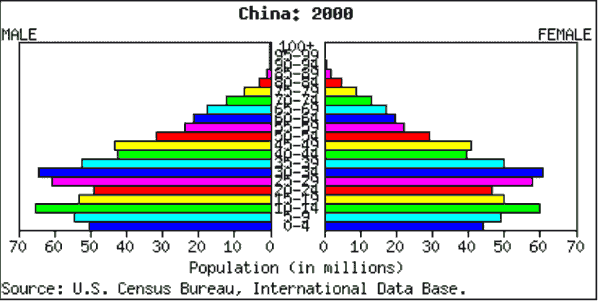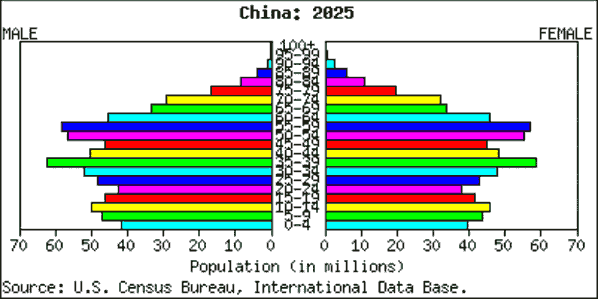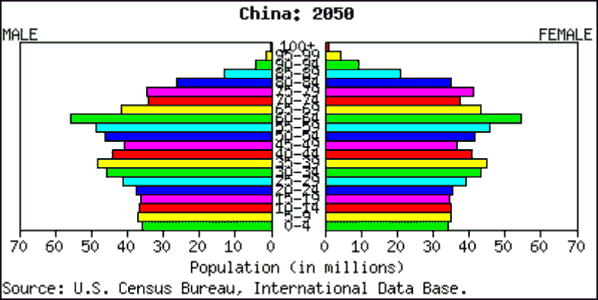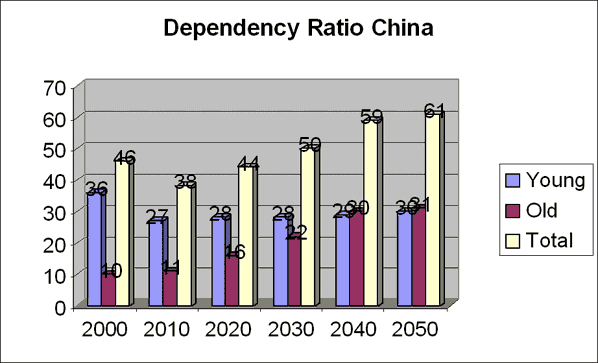
| ISSUE N° 4 November 2004 |
|
New Demographic
Features Download Shanghai Flash N° 4/2004 pdf-version By the end of 2003, China's population stood at 1.29 billion, accounting for 21% of the world's total population. Its family planning (one child) policy has been implemented since the end of the 1970s and has led to a reduction of 300 million births during the last thirty years, with the birth rate continuing to decline. In 2003, the net population increase was 7.7 million with a birth rate of 12.41‰ and a natural growth rate of 6.01‰, compared to an increase of 23 million persons per year at the end of the 1960s and early 1970s. As the most populous country in the world, China only has 7% of the world's arable land, 7% of fresh water, 3% of the forests and only 2% of oil resources. The strong population-control efforts of the government have supported its rapid economic growth recent years. As a result of this birth-control policy, within 30 years the demographic characteristics have now changed from a “high birth rate, low death rate and high growth rate” to a “low birth rate, low death rate and low growth rate”, a transformation that took many developed countries nearly one century to complete. However, this fast transformation has also led to disadvantages in the population structure, mainly in two respects – an ageing population and an imbalance in the sex ratio, which will lead to new problems and challenges, but at the same time, will also create new potential business opportunities. I. The Ageing Population 1.1. General Situation China has become the country with the fastest ageing process in the world and the largest population of senior citizens. Currently China has more than 130 million senior citizens who are above 60, more than 10 percent of the total population. By the middle of this century senior citizens in China will be exceeding 400 million, making up one fourth of the total population, whereas it takes twice that long for developed countries to cover the same process. Generally speaking, the declining fertility and the increasing longevity have contributed to this growing “white tide”. Over the last fifty years, life expectancy of the Chinese population has kept growing, from less than 40 years before 1949 to 71.4 years at present, approaching levels in developed countries. The population pyramids below show the ageing process is changing China's pyramid by growing larger and larger segments in the higher age brackets.
1.2. Social Security System 1.2.1. Basic Old-Age Insurance The growing ageing population has put mounting pressure on China's pension system. According to the China Statistics Yearbook 2003, pension payment at present is drawn from the current year's income, an accounting-on-cash-basis system that relies on a relatively young population structure. However, China will not have a sufficiently large young workforce to pay the social benefits for retirees with the rising burden of dependency in the near future.
In 1997, the Chinese government unified the basic old-age insurance system for enterprise employees in urban areas across the country by implementing a social-pool-plus-personal-accounts scheme. The government, instead of the enterprises, took the responsibility to pay pensions for the retirees. However, there were many employees retired before the start of the new system as well as many laid-off workers during the SOE reform whose personal accounts were empty. The government had to inject fiscal subsidies to pay for them during the transitional period. Meanwhile the contribution revenues from individual accounts were also diverted to pay for the deficits in the social pooling thus leaving the personal accounts empty as well. Therefore China's pension fund has so far been in deficit since the very beginning. The current annual deficit is estimated as around UD$ 20 billion. Till 2010, the accumulated deficit will reach UD$ 110 billion, according to a report by McKinsey (Pitsilis, 2002). 1.2.2 National Social Security Fund In an effort to build up reserves for future pension payments, China set up a National Social Security Fund in 2002. By the end of June this year, the total fund assets amounted to 143.2 billion Yuan (UD$ 17.3 billion) – but still not sufficient compared to the future needs of China's ageing society. President Xiang Huaicheng of the National Council of the Society Fund (NCSSF) said earlier this year that China's pension problem could basically be solved only if the fund reaches 2 trillion Yuan (UD$ 240 billion). Following his comments, Xiang announced a proposal on 17th September this year, that more than 12 trillion Yuan (UD$ 1.4 trillion), nearly one-tenth of China's State assets, will be transferred to the Social Security Fund within five years. The proposal was a response to the white paper titled “China's Social Security and Its Policy” issued by the Information Office of China's State Council on 7th September, the first-ever white paper in this field that showed the effort by the Government to improve the country's social security system. 1.2.3 Enterprise Annuity In addition to the compulsory basic old-age insurance, the Chinese government has encouraged the enterprises with suitable conditions to set annuities for their employees. In 1994, the National People's Congress promulgated the Labour Law stating that employers may sponsor supplementary pension insurance for their employees in their own context. Both enterprises and individuals will contribute to this annuity, which will be accumulated wholly for the specific purpose of retirement allowance and managed in the form of a personal account. Therefore a preliminary outline of China's pension system was formed: compulsory basic pension insurance including social-pooling fund and personal accounts, occupational complementary pension (enterprise annuity) and personal savings. With the reform of the pension system, in the longer term the personal accounts would be separated from the basic pension insurance and converged into enterprise annuities. The enterprise annuities would become the most important source of income for many retirees. But by the end of 2003, only about 7 million people have taken part in the enterprise annuity project, accounting for less than 10% of the basic pension insurance contributors in the country. 1.3 Social Security Fund Market Both domestic and foreign companies have shown great interest in China's social security fund market, lured by the market potential and the growing demand for professional services in this sector. The National Council for Social Security Fund released the long awaited result for the 2nd round selection of fund management companies in late October to add another four companies together with the previous six as its fund investment managers to help to run the UD$ 17.3 billion strategic reserve social security fund. Several joint venture fund management companies, including ABN AMRO Xiangcai Fund Management and Fortune SGAM Fund Management had applied for the position, but failed. So far, there are two joint-venture companies among the ten approved fund managers. As part of China's commitment to the World Trade Organisation (WTO), foreign institutions are allowed to do securities and fortune management in the country. But the limits put on these activities are still very strict. The second round competition began with the enterprises' annuity fund, which is operated in accordance with the market mechanisms. According to the Administration of Enterprises Pension Funds trial procedures started effectively from 1st May 2004. The Fund is now worth 50 billion Yuan (US$6 billion) and is expected to grow to 100 billion Yuan (US$12 billion) in a few years. Within China's WTO commitment the annuities market will be open to foreign insurers at the end of this year. A new regulation for the enterprises annuities fund management is expected to be released in November this year, which will set up the exact market entry thresholds for fund managers and clarify the standards and liabilities in the investment management. Chinese fund management companies are competing strongly to win the licences to manage the enterprises pension fund. Technically speaking, it is not much of a problem for a foreign company to enter the market, as there is a high demand for quality and professional investment management service as people are much concerned about a stable and good return of their pension fund. This year's policy loosening allowed qualified domestic insurers to invest their foreign exchange assets overseas. A government official said recently that a new regulation allowing social security funds to invest in overseas securities will also be released next month. II. Gender Imbalance According to the fifth national census conducted in 2000, the ratio of new-born males per 100 females in China has reached 117, much higher than the normal level of between 103 to 107. In some provinces, the ration topped at 100:130. The one-child policy and Chinese preference for male heirs have played a major part in this disparity, while prenatal sex selection of unborn children is the main reason for the result. Technology, such as ultrasonic scanning to predetermine the sex of an unborn baby, still leads to the abortion of unborn females in some cases. Many reasons lead to the outmoded notion of male preference. As elderly people in rural areas are not covered currently by the social security system, they mainly rely on the family for old-age support. Secondly, young male labour force is still a great asset in agricultural regions due to the backward productivity of agriculture. Meanwhile, China's traditional male-oriented culture and differentiated treatment of different genders in real life also contribute to the biased mentality. Such disparity will not only hurt female new-borns with unfair treatment, but will also raise a series of social problems. It is estimated that by year 2020, 40 to 50 million Chinese male aged 20-40 will not be able to find wives. It is feared already now that this unbalance will probably lead to casual sex and human trafficking. Moreover, these large numbers of unmarried, often undereducated young men form part of the floating population moving between China's urban cities. They also are prone to engage in high-risk sex, which leads to increased levels of sexually transmitted diseases. In 2003, the HIV-positive population in China was 840,000. The disease is now at the critical point of spreading from the high-risk to the general population. Without strongly effective measures, the infected numbers will increase to 10 million persons by the year 2010. This serious situation coinciding with the high-risk population of unmarried men will pose a huge treat to China's sustainable economic growth. III. Situation in Shanghai 3.1 Demographic Characteristics As China's economic, financial, trade and shipping centre, Shanghai accounts for 0.06% of the country's total area, but its population, standing at 13.42 million in 2003, accounted for 1.27% of the country's total. The natural demographic change in Shanghai has exclusively sustained negative growth for the consecutive 11 years since 1993. Thus Shanghai is the first city in China that has entered the stage of an ageing society, facing the dual pressure of ageing and an advanced ageing structure of the population. The city's average life expectancy was 79.8 years old in 2003, much higher than the average 71.4 years life expectancy in China. By the end of 2003, the senior citizens of age 60 and above reached 2.5467 million, accounting for 18.98% of Shanghai registered permanent residents and those of age 65 and above hit 1.9949 million, accounting for 14.87%, which indicates that ageing in the city has reached the average level of developed countries. It is forecast that in the coming period of time, the percentage of Shanghai's ageing of population will further grow. Despite of the negative natural growth rate, the overall population in Shanghai has sustained rapid expansion, owing to the constant influx of a migrant population. The number increased from 1.06 million in 1998 to 3.87 million in 2002, ranking second in the country, just after Guangdong Province. In order to further attract a young and skilled workforce, Shanghai has launched a new residence permit policy since 1st October 2004, giving migrant workers with fixed labour contract in Shanghai nearly the same treatment as registered citizens in the fields of education, insurance and pension plans. 3.2 Challenges and Opportunities 3.2.1 Market Potential for Products for Elderly People An investigation by the China Research Centre on Ageing showed that 42.8 percent of ageing people in urban districts possess savings. The percentage in Shanghai is much higher with its per capita GDP hitting US$ 5,642 in 2003, ranking number one in mainland China. Most of the savings and the accumulated retirement pension will pour into the market. Consequently the exploration of products for the market created by elderly people has drawn the attention of many business people. Anti-ageing products, tonics, garments and other age-related products appear on the counters. New vacations and services designed especially for ageing people such as tourism and gymnasia have emerged as well. However, the quantity, quality and style of the products still lag behind those for women and children. Due to the high diversity of China, there is no unified single Chinese market, but many different markets in different areas for different types of consumers. Elderly people in Shanghai tend to pay more attention to the quality and taste of life, therefore there is also demand on high quality medical service, cellular therapy, high-end cosmetics and garments as well as overseas tourism. Additionally, the family size in Shanghai has tended to miniaturisation with only 2.8 members each family in 2000. Unlike traditional Chinese family, many elderly people in Shanghai live by themselves. It is forecast that small apartment with elderly-caring facilities and service will be in large need in the near future. 3.2.2 Shortage of Migrant Workers in Some Areas Since the end of the Spring Festival this year, many cities in China, especially in the Pearl River Delta, are facing the problem of lacking labour, both in numbers and in skills. Due to the hukou (household registration) system, migrant workers will not be accepted as full members of urban communities even if they have worked for years in the cities. Therefore they will not have the same access to jobs, education, health services, insurance and social welfare benefits. In some areas the working conditions of migrant workers are very poor. Unpaid wages, increased cost of living in the cities, as well as lack of basic employment benefits are all contributing factors for the shortage of this labour force. Another reason for the migrant workers not to return to the cities is the new policy of the government directed at raising rural incomes and improving the economic situation in the countryside. So far the situation in the Yangtze River Delta is better. A series of new measures has been taken by the authorities to protect the rights of migrant workers. The average monthly payment in the Yangzi River Delta is about 8.5% higher than the national average. As a result, migrant workers “vote with their feet”. The movement has severely hit the manufacturing industry in some areas. Shanghai has a relatively strong government, proven by its impressive performance in the fight against the SARS disease in 2003. The series of new policies published by the government, such as the new residence permit policy, as well as insurance and pension plans for migrant workers, has created a comparatively open and fair environment and have attracted higher-skilled workers. As a result, it is not easy any more to find skilled employees on different management levels in neighbouring cities like Suzhou and Ningbo, although business costs are lower there. However, with the process of an ageing population, it is a long-term task for the government to attract and provide job-training for a large pool of skilled workforce, both urban and migrant, and constantly improve its productivity. 3.2.3 High Density of Population The population density in Shanghai remains the highest in China with 2,588 people per square kilometre. In addition, the population is unevenly distributed. The villages in the suburban areas are small and the residents are too scattered, unfavourable to the rural modernisation drive. On the other hand the density in the downtown areas is too high. There are over 50,000 people per square kilometre in Huangpu, and 40,100 people per square kilometre inside the inner ring. The strongly concentrated population in the downtown areas has resulted in considerable environmental and severe transportation problems. IV. Conclusion China has grasped the demographic bonus for development over the last two decades. The huge pool of labour force has provided the necessary entry-level man-power for the industry when China started taking off after 1978. Furthermore, large amounts of bank savings deposited by the younger population are continuously supplying the heated investment needed for development. In the meantime, increasing incomes and relatively low dependency rates encourage spending on housing, automobiles, education, tourism and other services. However, China's favourable demographics will start to turn against its booming economy within several decades when the country's population is getting older. Related authorities have already put the task of seeking solutions of the demographic changes at the top of their agenda. The Government has already shown its strong effort for better education and health care. It is very likely that this huge human capital investment will help China to work its way through the age structure. Nevertheless, the per capita education duration in China is now only 7.85 years, a level of education achieved by the U.S. 100 years ago. There is still a long way to go, before trained labour in sufficient numbers and sufficient quality should help the country to go on with its economic and social development. Stella Nie 9.11.2004 Consulate
General of Switzerland |
Back to the top of the page
Page created and hosted by SinOptic



